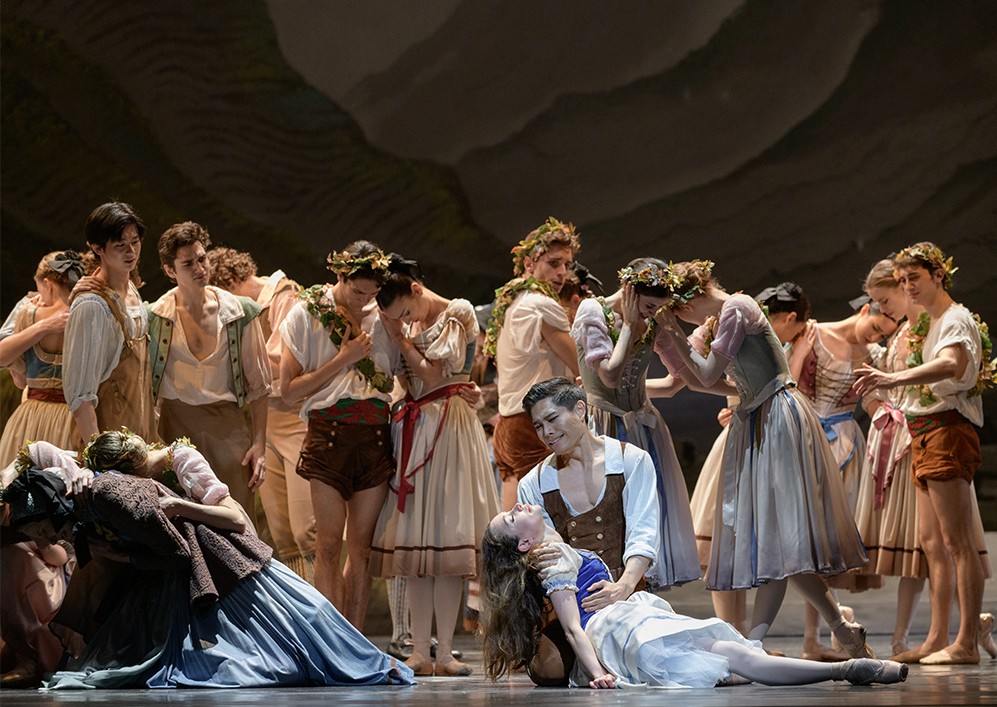
Teaching, documenting, rehearsing
How ballet masters revive a ballet
Text: Rosalie Overing
Photo: Judy Maelor Thomas during rehearsal 7e Symfonie (Toer van Schayk) | © Altin-Kaftira
Fourteen years and eight runs after its premiere in 2009, the production of Giselle by Rachel Beaujean, associate artistic director of Dutch National Ballet, and former star dancer Ricardo Bustamante has lost none of its popularity. This autumn, the production is being presented once again on the stage of Dutch National Opera & Ballet. But revivals of ballets like Giselle don’t just happen automatically, of course – that’s a job for ballet masters like Judy Maelor Thomas.
The job of ballet master is probably not as generally well-known as that of ballet dancer or choreographer, but it is essential to a ballet company nonetheless. Ballet masters play an important role in rehearsing ballets, whereby their exact activities depend on the production – new or revival – and the requirements of the artistic team involved in it. In brand-new productions, for instance, the role played by ballet masters is mainly a supporting one, and they assist the choreographer where necessary. It’s the same for existing ballets that are being performed by Dutch National Ballet for the first time, which are often taught to the dancers by people from outside the company. If there are ballets on the programme that have been danced previously by the company, which the ballet masters learned themselves on that occasion, then they often teach the dancers those ballets themselves.
In the case of Giselle, Judy Maelor Thomas and her fellow ballet masters have experienced both situations. Judy says, “The first time we did this version of Giselle, in 2009, the production was new for the most part, and Rachel and Ricardo taught all the steps to the dancers. In that case, your job as ballet master is to help them and advise them if requested, but mainly to ensure you remember the sections for which you’ll be responsible when the production is revived later on, because then it’s up to you to teach the dancers their roles.”
Benesh-notation
Each ballet master has their own way of recording ballets. Judy herself uses Benesh Movement Notation, a dance notation system used to document movements. “It’s a fairly logical system that can be understood by anyone, in principle. You work with five lines that represent the floor and the dancer’s knees, waist, shoulders and top of the head. On these lines, you use three basic symbols to draw the position a dancer takes, as seen from the back.” Benesh notation is not used by all ballet masters, however. “I still use Benesh notation myself because I find it the easiest method, as after my dancing career I studied choreology (dance notation – ed.) at what was then the Benesh Institute. And after that, I spent eight and a half years as a choreologist with Dutch National Ballet, alongside my position as ballet master. But choreology isn’t used by all ballet masters by any means; everyone has their own way of remembering and documenting ballets.” And nowadays, extensive video recordings are made of all the productions, which can be referred to when a ballet is revived. “We even film from above, to get a more detailed view of the dancers’ positions on the stage.”
“...everyone has their own way of remembering and documenting ballets”
So does a revival always have to be exactly the same as the original production? “The steps are set for the most part, of course, but the dancers – particularly the principals – are given some leeway to play with steps and the dynamics”, explains Judy. “The amount of leeway you can give depends on the ballet and the choreographer. In the case of some works, there’s little discussion about what it should look like, but works by other choreographers give the dancers more scope for their personal interpretation. A ballet like Giselle is, of course, based completely on classical ballet technique. So when the corps de ballet perform a certain movement, the dancers are trained to all do it in the same way.”

Big groups of dancers
In the coming period, Judy and her colleagues will start rehearsing for the ninth run of the Giselle production by Rachel Beaujean and Ricardo Bustamante. During the rehearsal process, Judy is responsible for the group dances and scenes from the first act. For most of the other full-length classical ballets, she is chiefly concerned with the group sections as well. “Actually, that happened purely by chance. When I’d just arrived here, in 2006, I took over the group section rehearsals from a ballet master who was retiring. I started off with the big group dances in The Sleeping Beauty and Swan Lake – for example, those from the third act of Swan Lake. Nowadays, we rehearse that part with smaller groups at first, but at the time we had all the dancers in the studio at once. I remember suddenly standing in front of this enormous group and thinking ‘okay, how am I going to deal with this?’ But over the years, you get more and more adept at it.”
More than fifteen years later, Judy still prefers to be in the studio with a big ensemble of dancers. “Sometimes I also rehearse the occasional pas de deux with the principals, in the more contemporary works, for example. But I really enjoy working with big groups. An important part of it is sensing the atmosphere in the studio and then seeing what’s needed in order to motivate the group. You have to make sure that everyone in the studio feels at ease and is in the right frame of mind to work. That’s always an interesting challenge.”